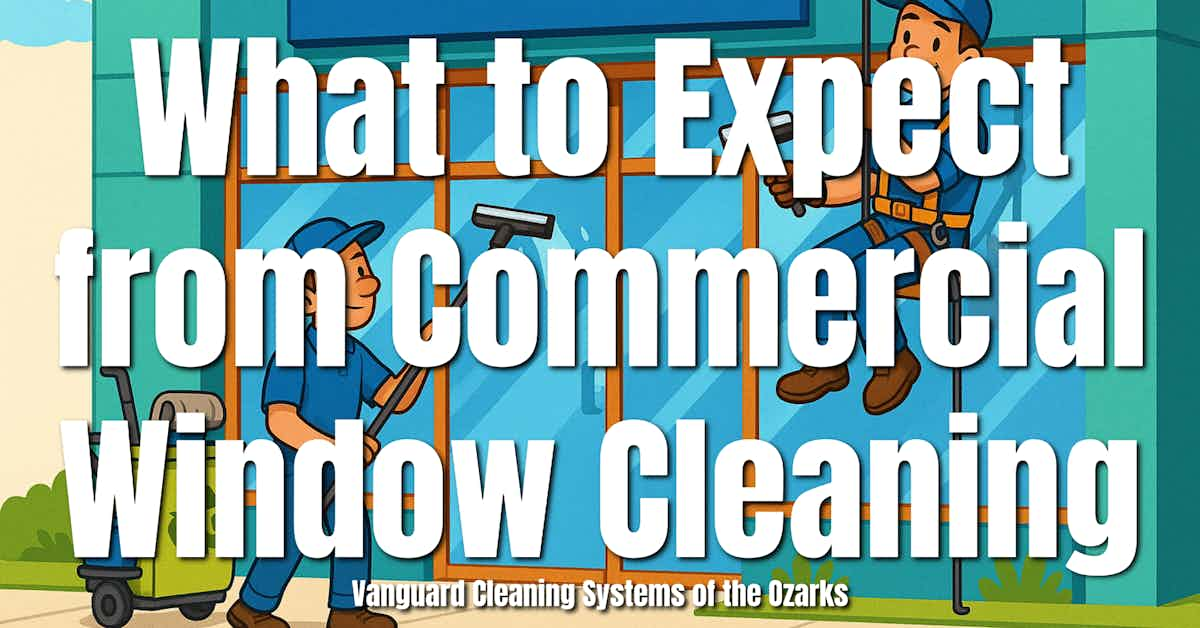A professional window cleaning service delivers more than shine—it safeguards safety, reputation, and workplace quality.

Introduction: Why Window Cleaning Matters
Windows are more than panes of glass. They influence how natural light flows into a building, how employees perceive their workspace, how visitors judge professionalism, and even how energy-efficient a property can be. Yet window cleaning is one of the most underestimated services in facility management.
For businesses, commercial window cleaning services are not just cosmetic. They play a role in safety, building longevity, and brand reputation. Whether you manage a downtown office tower, a retail store, or a manufacturing facility, knowing what to expect from a professional service helps you set realistic standards, secure value for money, and protect both property and people.
Pre-Service Assessment: The First Step
A professional cleaning service begins with a thorough pre-service assessment.
- Inspection of property: The team evaluates window type, condition, accessibility, and dirt accumulation.
- Identification of challenges: Issues such as mineral deposits, graffiti, bird droppings, or construction residue are flagged.
- Safety risks: Buildings with unusual architecture, older windows, or hard-to-reach sections require specific access methods.
- Quote preparation: Pricing depends on square footage, number of windows, frequency of service, and equipment required.
This step ensures both parties have a clear understanding of expectations before service begins.
Professional Equipment and Techniques
Commercial window cleaning is defined by the tools and methods used.
- Traditional tools: Squeegees, microfiber cloths, and extension poles remain core equipment for ground-level cleaning.
- Water-fed pole systems: These use purified water delivered through telescopic poles, leaving windows streak-free without chemicals.
- High-rise access: Rope access (abseiling), boom lifts, and scaffolding are used for tall buildings. Workers are certified in fall protection and equipment use.
- Eco-friendly practices: Many companies now prioritize low-impact cleaning solutions to protect indoor air quality and reduce chemical runoff.
Clients should expect equipment that matches building type and height, with techniques that meet both safety and environmental standards.
The Cleaning Process
While service details vary, most companies follow a structured cleaning process:
- Interior cleaning: Removal of dust, fingerprints, and smudges from inside windows.
- Exterior cleaning: Elimination of dirt, grime, pollution residue, and weather effects.
- Detail work: Frames, tracks, sills, and sometimes screens are included.
- Special services: Options may include scratch repair, hard water stain removal, or solar panel cleaning.
- Finishing: A streak-free result with no residue or spotting.
A reliable company documents what is included in a contract so there are no surprises.
Safety and Insurance
Safety is non-negotiable in window cleaning.
- OSHA compliance: Professional cleaners follow fall protection, scaffolding, and chemical handling guidelines.
- Trained technicians: Workers must be trained in rope access, ladder safety, and aerial lift operation.
- Insurance coverage: Liability insurance protects clients from accidental damage. Workers’ compensation protects employees.
- Chemical safety: Proper labeling, storage, and dilution of cleaning agents prevent health hazards.
Clients should expect certifications, documented safety protocols, and proof of insurance before any work begins.
Scheduling and Service Frequency
Flexibility is a hallmark of commercial cleaning contracts.
- Frequency: Options range from one-time cleanings to recurring monthly, quarterly, or semiannual services.
- Timing: After-hours, overnight, or weekend scheduling minimizes business disruption.
- Customization: High-traffic businesses may require more frequent cleaning, while offices in cleaner environments may need less.
- Emergency services: Many providers offer rapid-response cleaning after storms, accidents, or construction projects.
Facility managers should expect clear scheduling aligned with operational needs.
Post-Service Inspection and Accountability
Trustworthy providers do not leave without confirming satisfaction.
- Walkthrough inspections: Supervisors review work with the client to ensure quality.
- Photo documentation: Before-and-after photos provide proof for hard-to-reach windows.
- Satisfaction guarantees: Many companies commit to re-cleaning missed areas at no additional charge.
- Performance tracking: Larger providers may use apps or portals for service documentation.
Post-service accountability ensures standards are consistently met.
Pricing and Contract Transparency
Window cleaning costs are influenced by multiple factors.
- Building size and height: Taller structures require specialized equipment and certified technicians.
- Window type: French panes, skylights, or architectural glass may add complexity.
- Frequency: Regular contracts typically reduce per-visit costs.
- Access issues: Landscaping, nearby traffic, or restricted access can affect pricing.
Clients should expect detailed quotes, transparent line items, and no hidden fees.
Sustainability and Green Practices
Environmental responsibility is increasingly part of commercial window cleaning.
- Purified water systems: Reduce chemical use and runoff.
- Biodegradable cleaning agents: Protect local ecosystems and indoor air quality.
- Microfiber technology: Limits disposable material waste.
- Green certifications: Some providers align with LEED or other environmental programs.
Expect sustainability to be part of both product selection and operational practices.
Staff Training and Professionalism
Technicians are more than labor—they are trained specialists.
- Technical training: Use of lifts, ropes, water-fed poles, and specialized glass treatments.
- Customer service: Professional appearance and conduct while on client property.
- Security protocols: Respect for confidential environments like offices, schools, and hospitals.
- Ongoing education: Updates on safety standards, new products, and emerging technologies.
Clients should expect technicians who are both skilled and professional in demeanor.
Technology in Modern Window Cleaning
Advances in technology are reshaping the industry.
- Route planning software: Improves efficiency in scheduling and reduces costs.
- Drones: Emerging tools for inspection and cleaning of inaccessible areas.
- IoT integration: Monitors equipment use and performance in real time.
- Cybersecurity: With digital systems, protecting customer data has become a priority.
Expect window cleaning companies to integrate technology for efficiency, documentation, and safety.
Risks of Poor Window Cleaning Services
Choosing the wrong provider has consequences.
- Property damage: Scratched glass, damaged seals, or water leaks.
- Health hazards: Chemical misuse or lack of safety compliance.
- Reputation loss: Streaky, dirty windows undermine professional image.
- Financial risk: Lack of insurance can leave clients liable for accidents.
Expect professional providers to mitigate these risks through training, documentation, and insurance.
Industry Trends
- Outsourcing growth: More organizations outsource window cleaning for cost efficiency and compliance.
- Demand for green cleaning: Sustainability expectations are increasing across industries.
- High-rise expansion: Urban growth is fueling demand for advanced rope access techniques.
- Focus on accountability: Clients increasingly require digital reports and satisfaction guarantees.
Expect providers to adapt to evolving client demands and industry standards.
Frequently Asked Questions
How often should windows be cleaned in commercial buildings?
Most offices benefit from biannual cleaning, but high-traffic or high-visibility spaces may require monthly service.
Are interior and exterior windows both included?
Yes, though contracts may specify services separately. Always confirm inclusions.
Do companies carry insurance?
Reputable providers carry liability and workers’ compensation insurance. Always request proof.
What cleaning products are used?
Most providers use purified water systems and eco-friendly cleaning solutions for safety and sustainability.
Is it safe to clean high-rise windows?
Yes. Trained technicians use OSHA-compliant equipment like rope systems, scaffolding, and lifts.
People Also Ask (PAA)
What services are included in commercial window cleaning?
They include interior and exterior glass cleaning, frame and sill maintenance, and specialized treatments for stains or residue.
How much does commercial window cleaning cost?
Costs depend on building size, height, window type, and frequency. Detailed quotes outline exact pricing.
Can window cleaning be scheduled after business hours?
Yes. Many companies offer evening and weekend service to avoid disrupting operations.
Why is commercial window cleaning important?
It maintains building appearance, protects property value, supports health and safety, and creates positive impressions.
Conclusion: Expect Professionalism and Accountability
A commercial window cleaning service should deliver far more than sparkling glass. From pre-service assessments to advanced equipment, safety compliance, and post-service inspections, the right provider brings professionalism, transparency, and accountability.
Facility managers and business owners should expect detailed contracts, eco-friendly practices, insured staff, and flexible scheduling. By setting high standards and working with experienced providers, organizations gain more than clean windows—they gain a safer, healthier, and more professional work environment.
Vanguard Cleaning Systems of the Ozarks' franchise-owned custodial service provider business cleans more than 8M sq. ft. weekly, maintaining an industry-topping 95+% of its customer base, year-over-year, and boasting more than 60 5-star Google reviews.
Need more capability from your vendor partners? --Let's talk.
In Oklahoma, dial 918-960-4450
In Arkansas, dial 479-717-2410
In Missouri, dial 417-812-9777
References
Brown, S., Fox, S., Hewage, C., & Khan, I. (2022). Threat modelling of cyber physical systems: A real case study based on window cleaning business. SN Computer Science, 3(5), 1–16. https://doi.org/10.1007/s42979-022-01021-3
Gussow, L. (2008). Case 1: Window cleaner ingestion. Clinical Toxicology, 46(3), 187–188. https://doi.org/10.1080/15563650701672094
Sarquis, A., Peters, B., Coffey, L., Hershberger, J., & Bucheit, R. (1995). Creating a window cleaner company. Journal of Chemical Education, 72(4), 344–345. https://doi.org/10.1021/ed072p344

